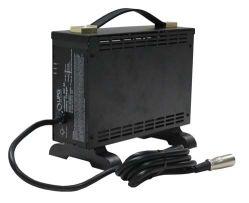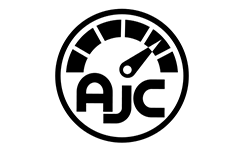Charging SLA Batteries
Charging SLA Batteries
A Sealed Lead Acid battery is a secondary cell battery, meaning it can be re-charged. Charging an SLA battery is accomplished by sending electrons through the battery to reverse the chemical reaction that creates the energy output of the battery. The electrons in an SLA battery are stored in the positive plate which is made of lead dioxide (PbO2). The negative plate is pure lead, often in sponge form. The electrolyte is a dilute sulfuric acid (H2SO4) solution. When the battery is discharged, both plates are converted to lead sulfate (PbSO4) and the sulfuric acid is converted to water. Sending electrons back through the battery, or charging it, causes a reaction that converts the battery components back to their charged state.
State of Charge (SOC), is used to describe how full a battery is. When a battery is fully charged, the SOC is 100%.
Constant Current
The most common charger for SLA batteries uses the constant current charge (CC). This keeps a small constant current running through the battery for a long time. They are typically designed for a 12 to 16 hour charge time.
Constant Voltage
Another common charger uses constant voltage (CV). This keeps a constant voltage across the battery. When a discharged battery is hooked up to the charger, a high initial charge current flows into the battery. As it continues to charge the current tapers off. This type of charger typically completes the charge in 2 to 4 hours, and is stopped by a timer to prevent overcharging.
Constant Current/ Constant Voltage
A third, more advanced type of charger uses both constant current and constant voltage (CCCV). It also has a temperature compensation circuit to sense the temperature of the environment where you are charging the battery. As the temperature of the charging environment increases, this charger will vary the current and voltage for optimal charging. At the beginning of the charging session, a moderately high current goes into the battery. As the voltage rises, the current lowers until it reaches a predetermined value that ends this part of the charging process. The voltage and current are then lowered to provide a maintenance charge, or float, and this stage will continue until the battery is removed from the charger.
In SLA batteries, the lead acid chemistry will gain capacity above 75 degrees Fahrenheit, and lose capacity below 60 degrees, so storing and charging them between 60? and 70 degrees Fahrenheit is recommended for optimal performance.

Over Charging
Over charging SLA batteries shortens their lifespan and can be dangerous. If you are not using a CC/CV charger, and the battery is left on the charger past the full charge, the battery can create excess gas and will diminish the capacity of the battery. The sulfuric acid will break down and form Hydrogen and Oxygen gases. In a sealed lead acid battery, this can result in the buildup of pressure and temperature. There is a safety valve that will vent the gas, but often some of the electrolyte solution is ejected as well, which reduces the capacity of the battery. The lost capacity of an overcharged SLA can’t be recaptured.
Because all SLA batteries can produce this gas, always charge them in a well ventilated area. Also keep in mind that a discharged battery will freeze faster than a charged battery due to the higher water content, so make sure the battery isn’t stored or charged in a cold setting, and always store batteries fully charged.
Sulfation
As a battery discharges, lead sulfate is produced, and it is reconverted to lead and lead dioxide as the battery recharges. But if the battery is stored without a full charge, or if the battery is never fully recharged, that lead sulfate may harden and then resist being converted back to lead dioxide and pure lead. The battery loses capacity as a result, and the lost capacity can’t be reversed. To avoid sulfation, make sure the battery is fully charged on most cycles.
Deep Discharge
SLA batteries do not tolerate repeated deep discharges well. If the battery does become completely discharged, all of the materials inside are converted to water and lead sulfate, and it might be difficult to reverse the chemical reaction to produce a charge. Some batteries designed to deal with deep discharges have an outsized plate that allows a recharge even when fully discharged. When possible, you should re-charge the battery after each use to avoid deep discharge.
Optimizing Battery Life
You can extend the life of your sealed lead acid battery if you are careful about charging it. More batteries are damaged by bad charging techniques than from all other causes. Check the manufacturer’s recommendation for charging and use the proper charger for the battery. Most chargers will only properly charge one type of SLA battery and shouldn’t be used for a battery with a different chemistry.
Using a CCCV charger, which uses a microprocessor to determine temperature, voltage and current SOC will reduce the risk of overcharging or under charging, and extend the battery’s useful lifespan.
